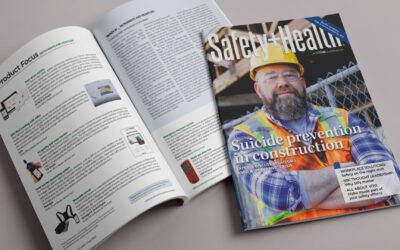Safety management systems (SMS) are crucial in any workplace, as they set the standard for how to complete tasks properly to minimize chances of injury. When your employees get hurt, everyone loses — they miss days of work in order to get treatment and complete rehabilitation, you have to pay worker’s compensation and there’s the potential of losing one of your people for good.
A good employer wants to do everything they can to avoid a situation like this, and safety management systems are a great place to start. Some unions and insurance companies will even require you to have one, so it’s best to develop one now and keep all parties protected. StrongArm Tech is here to take you through some of the fundamental practices that will get your company back to business while being safer than ever.
Steps to Implement a Safety Management System
Implementing your SMS will take time, but by following these steps, you can make sure your company is on its way to safety success.
1. Designate a Safety Management Team
Does your company have a safety management team? If not, it’s time to create one. If you do, it may be time to reevaluate their effectiveness and bring in new members. When you’re revamping your safety system, it’s likely that your current team has plenty of room for improvement. However, making any change can be a big step that not everyone is prepared to take.
For your program to be successful, your leaders need to be excited about these changes and enthusiastic about getting the rest of your employees involved in the process. They should be good communicators and have working relationships with all the sectors in your company. A new SMS can take months to implement and see results, so your team needs to stay dedicated to the cause and be ready to navigate developments as they appear.
2. Make Goals and Plan for Challenges
How will you know whether your new SMS is succeeding? Establishing key success objectives and tracking metrics allows you to make quantifiable goals and see when you’re reaching them. Some metrics will take longer than others to measure, like worker’s compensation costs, but you should still be able to see if you’re on the right track based on times between incidents and the number of risks reported.
Even if your safety management team is running things perfectly, challenges are bound to arise as everyone in the workplace gets on the same page. Furthermore, some jobs inherently have more risks than others, all of which need to be accounted for and have a plan for maximum safety in place. Get ahead of these by planning for them from the beginning of SMS development, creating profiles about high-hazard spaces, how you can mitigate their risks and what to do when safety measures fail.
3. Get the Word out About New Measures
For maximum effectiveness, everyone has to be aware of new procedures and who they can bring concerns to when they arise. Send your safety management team to review new protocols with every shift and department. Make sure all leadership personnel has a copy of the best practices so they can review them and answer questions from their employees.

4. Ensure Transparency and Accountability
Safety in the workplace is for everyone, and each employee in your company needs to contribute to preventing incidents. The only way they can do that is if they have easy and unfettered access to your complete SMS with all its guidelines, policies and contingencies.
Once everyone knows what to expect, every person on shift becomes a vessel of accountability for your system. They can point out when someone is putting themselves or others at risk and react more quickly if something goes awry.
Still, it’s good practice to have designated safety leaders, whose job it is to identify noncompliance, know where safety equipment like fire extinguishers are and how to use them and run occasional training seminars to ensure long-term retention.
Factors to Consider When Implementing a Safety Management System
Choosing software for your SMS that covers everything you need is a crucial factor in the long-term success of your program. As you look at your options, don’t let price be the sole factor that makes your decision. Consider other needs such as:
- Business needs and practices: There are many software options for safety management available, so finding one that aligns with your needs should be your utmost priority. Think about what you need most from your solution. Are you focused on air quality monitoring? Do you need detailed information about how your employees lift and move products? How will this system fit into your existing management and disciplinary practices?
- Risk assessment and gap analysis: Good inspection software is constantly monitoring your property and looking for anything noncompliant. It helps you maintain OSHA regulations and your personal safety standards, encouraging all users to keep safety at the forefront and alert management when something is amiss.
- Safety training: Training your staff in proper safety protocol is one of the best ways to jumpstart your program and show employees how to avoid unsafe behaviors that may have become habits. Your safety management system should help them retain this knowledge through real-time reminders, notifications of potential incidents and certificates to gauge competencies.
- Collaboration needs: Your system should encourage the sharing of information at all levels. Most importantly, all employees should have access to the information they need. Other collaboration opportunities include allowing spaces for feedback, questions on procedures and reports of possible violations, risks or incidents.
Calculate Your Safety ROI With StrongArm’s Safety Management System

At StrongArm Tech, we know many workplace injuries are preventable with the right training, direction and guidance. The SafeWork System and our FLEX sensors keep your Industrial Athletes safer and more focused than ever. We designed our wearable technology to be as least constrictive as possible through our X-pack carrier, making it so workers can simply situate it on their backs and begin their days.
Throughout the day, the sensor records information on noise levels, air quality and body movements, alerting workers through vibration when they’re in an unsafe situation. Managers and other members of leadership can observe results through the SafeWork Dashboard and make adjustments where necessary, enhancing the existing safety system beyond what you thought was possible.If you’re ready to see how our safety management system gives you a return on investment above all others firsthand, contact StrongArm Tech today about starting your pilot period. Our custom data reports show an average of 200% ROI for our clients.
Links:
https://www.osha.gov/safety-management/management-leadership
https://www.faa.gov/about/initiatives/sms/explained/components
https://www.osha.gov/safety-management/hazard-Identification




